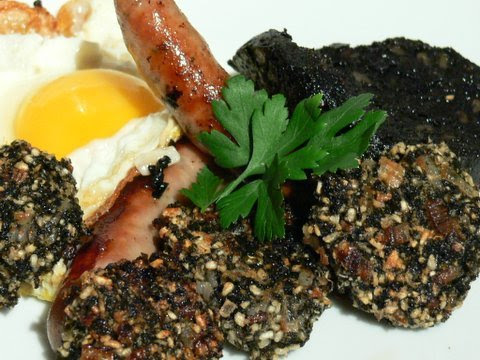The laverbread recipe is more than just a method for preparing seaweed—it’s a treasured symbol of Welsh identity and culinary tradition. Made from laver, a nutrient-rich edible seaweed, laverbread (pronounced lah-ver) has graced the tables of coastal Welsh communities for generations. It’s celebrated not just for its unique, savory flavor but also for its outstanding health benefits.
This classic dish is often associated with a traditional Welsh breakfast, served alongside bacon, cockles, and toast. While laverbread might be unfamiliar to many outside the UK, its nutritional value, rich umami taste, and sustainable sourcing make it increasingly popular among health-conscious foodies and chefs worldwide.
In this guide, you’ll learn the history behind laverbread, how to source and cook it properly, and get a step-by-step laverbread recipe you can easily recreate at home.
A Quick Overview: What Is Laverbread?

A Traditional Seaweed Delicacy
Laverbread is made by boiling fresh laver seaweed (Porphyra) for several hours until it becomes a soft, dark green purée. This purée is either eaten as-is, seasoned and spread on toast, or rolled in oatmeal and fried into laver cakes. Its taste is rich, savory, and often compared to oysters or spinach with a mineral tang.
In Wales, laverbread is sometimes dubbed “Welshman’s caviar” and is regarded with immense pride.
Health Benefits of Laverbread
Packed With Nutrients from the Sea
Laverbread is not just a cultural gem; it’s a nutritional powerhouse:
- Rich in iodine: Essential for healthy thyroid function.
- High in protein: Especially beneficial for vegetarians and vegans.
- Loaded with vitamins: Including A, B12, C, E, and K.
- Antioxidant-rich: Helps reduce inflammation.
- Low in calories and fat: Perfect for a clean-eating diet.
According to a BBC Good Food report, laverbread is among the healthiest traditional foods in the UK.
Where to Buy Laverbread or Laver Seaweed
You can find pre-prepared laverbread in tins or vacuum-packed in Welsh markets and online from specialty British food suppliers. If you want to make it from scratch, you’ll need raw laver seaweed, which can be:
- Foraged (with proper knowledge of clean, sustainable harvesting zones)
- Purchased dried from Asian or health food stores
- Sourced online from UK-based seaweed farms like The Pembrokeshire Beach Food Company
Always ensure that your laver is food-grade and harvested from clean, unpolluted waters.
Authentic Laverbread Recipe
Simple, Traditional, and Delicious
Ingredients:
- 300g (10 oz) fresh or rehydrated laver seaweed
- Water (for boiling)
- Pinch of sea salt (optional)
- Oatmeal (optional, for laver cakes)
- Butter or lard (for frying)
Instructions:
- Boil the laver
Place the laver in a pot with enough water to cover. Simmer gently for 4–6 hours until it breaks down into a soft, mushy texture. Stir occasionally and top up water as needed. - Drain and season
Once softened, drain any excess water and add a pinch of sea salt. The result is now ready-to-eat laverbread. - Eat it traditionally
Spread it on toast, or serve warm with bacon and cockles. - Make laver cakes (optional)
- Mix laverbread with oatmeal until firm.
- Shape into patties.
- Fry in butter until golden on both sides.
Laver cakes are particularly popular during breakfast in South Wales.
Modern Twists and Serving Suggestions

Elevating Laverbread in Contemporary Cuisine
- Laverbread risotto: Stir into a seafood risotto for a natural umami kick.
- Laverbread pasta: Use it like pesto to coat linguine with lemon zest.
- Sushi-style nori rolls: Use as a substitute or complement to nori.
- Laverbread toasties: Combine with cheese for a gourmet grilled sandwich.
Even high-end chefs, including some Michelin-starred kitchens in the UK, are now experimenting with laverbread as a coastal umami enhancer.
Cultural Importance of Laverbread in Wales

Laverbread isn’t just food—it’s history. It dates back centuries and remains a proud culinary tradition:
- Traditionally consumed in coastal areas like Swansea, Carmarthenshire, and Pembrokeshire.
- Celebrated on St. David’s Day as a national dish.
- Protected under the UK Geographical Indication Scheme.
Laverbread also appears in poems, songs, and even politics as a representation of Welsh heritage.
Frequently Asked Questions (FAQs)
Q1: What does laverbread taste like?
It has an earthy, briny flavor with umami notes, often compared to oysters or seaweed spinach.
Q2: Can you eat laverbread cold?
Yes, it can be eaten hot or cold. Many people enjoy it cold on toast with butter.
Q3: Is laverbread vegan?
Absolutely. It is 100% plant-based and suitable for vegans and vegetarians.
Q4: How do I store laverbread?
Keep it refrigerated in an airtight container for up to a week, or freeze for longer storage.
Q5: Is laverbread safe for everyone?
Yes, but due to its high iodine content, individuals with thyroid conditions should consult a doctor before consuming large amounts.
Image Suggestions for SEO
- Traditional Welsh breakfast plate with laverbread, cockles, and bacon
Alt: traditional Welsh breakfast with laverbread - Close-up of laverbread paste on toast
Alt: laverbread on toast with sea salt - Cooking process of laverbread in a pot
Alt: boiling laver seaweed for laverbread recipe
Conclusion: A Timeless Taste of the Sea
The laverbread recipe is a celebration of Welsh culinary heritage and sustainable sea-based nutrition. Whether you’re intrigued by its health benefits or eager to explore international flavors, laverbread is a humble yet flavorful dish that’s gaining global recognition.
Give this traditional recipe a try and experience a unique slice of Wales. You might just discover your new favorite comfort food from the sea.

